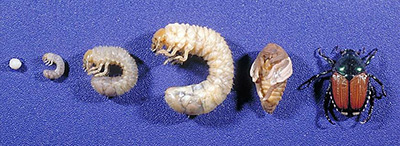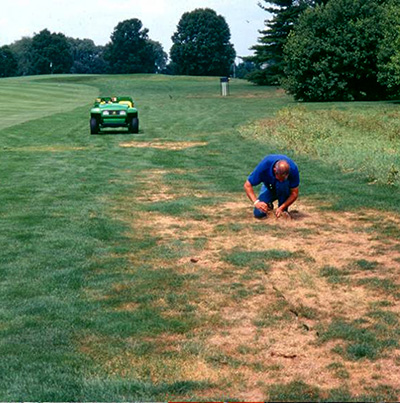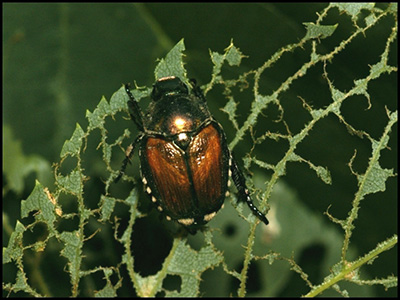
Japanese beetle: Tips for your lawn
DOWNLOADMay 16, 2017 - David Smitley
Origin and distribution
The Japanese beetle, Popillia japonica Newman, is a native of Japan. It was first found in the United States in New Jersey in 1916. Since then, it has gradually spread westward and has been reported in every state east of the Mississippi River. Individual beetles were collected in Michigan in the 1930s and those areas were subjected to intensive chemical application in an effort to eradicate the insect. It did not become established in the Detroit area until the early 1970s. Japanese beetle can be found in most locations south of a line from Muskegon, Michigan, to Bay City, Michigan. It has also been reported in damaging populations in numerous areas in the northern Lower Peninsula.
Pest status
Japanese beetle larvae can cause serious damage to golf course fairways and occasionally to home lawns. It normally is not a problem of non-irrigated turf. However, with frequent rain in July and August, the adults will readily lay eggs in non-irrigated turf. The adults are voracious feeders that damage a wide variety of ornamental shrubs and trees. If the local population is high enough, the most susceptible hosts such as lindens and roses can be completely defoliated. Japanese beetle is also a quarantine concern to commercial growers. Sod, soil or nursery stock must be certified as free of Japanese beetle if it is going to be shipped to states without Japanese beetle.

Japanese beetle life stages. L-R: Egg, 1st instar, 2nd instar, 3rd instar, pupae, adult. Photo by Dave Shetlar, OSU.
Injury
Japanese beetle grubs are actively feeding on grass roots from April to the end of May and from August to November. The larvae prune off the roots, causing the turf to have difficulty maintaining water uptake. Damage becomes evident during droughty periods and is typically observed in the fall if larval numbers are high. A secondary concern is skunks, raccoons, crows and geese feeding on the grubs. They can tear up large patches of turf as they dig for the grubs.

Japanese beetle damage on a golf course. Photo by MSU Entomology.
The adults emerge in early July and feed on the leaves of nearly 300 species of susceptible plants. The most favored include apples, cherries, grapes, peaches, plums, blueberries, asparagus, beets, broccoli, rhubarb, snap beans, sweet corn, soybeans, birch, crabapples, hollyhocks, linden, maples, mountain ash, roses and sassafras. Adult beetles feed on the top of the leaf, eating the tissue between the veins, leaving the leaves skeletonized. If populations are high, they can remove all of the green leaf material from the plants.
Life history
Adults are 0.375 to 0.5 inch long. The thorax is green and wing covers are metallic reddish brown. There are five tufts of white hairs on both sides of the abdomen and a pair of tufts on the end of the abdomen. The legs and head are black. The larvae are white C-shaped grubs varying from 0.125 inch when newly hatched to about 1 inch when fully grown. Eggs are laid in July through September on turf. The larvae hatch about 10 days later and begin feeding on the grass roots
If adequate moisture is available from rain or irrigation, the grubs will molt to second and then third instars by mid-September. The grubs dig deeper into the soil to avoid the frost as temperatures drop in the fall. The grubs move back up to the grass roots in April and begin to feed again. The larvae pupate in early June. Adults emerge between late June and the middle of August. In a normal year, most of the adults emerge in July. They tend to gather in large numbers on shrubs and trees after emerging and can often be found congregating in balls of a hundred or more beetles on the turf.

Adult Japanese beetle. Photo by Fred Baxendale.
Population reduction
A number of insect parasites and predators feed on Japanese beetle. Wasps that parasitize the larvae, flies that lay their eggs on adults and pathogens that infect larvae may also help keep Japanese beetle populations under control. Natural enemies of Japanese beetle will probably take several years to catch up with the initial wave of the population. Once these natural factors become established, populations of Japanese beetle will become more tolerable. This may take five to 10 years after the beetle reaches damaging levels. Dry conditions in late June and early July will also reduce the population for the following fall and next year.
Japanese beetle traps
Traps baited with a pheromone and a floral bait are commercially available at many lawn and garden stores. These are useful to determine when adults are beginning to emerge to help time chemical applications to reduce adult feeding damage. These traps also will help give some indication of the severity of the population in an area. Because the traps tend to attract Japanese beetle adults from the surrounding area, they may contribute to damage to nearby ornamentals and turf by attracting beetles to the vicinity of the trap. Although the traps are often sold as a control measure, it is not likely that trapping will reduce the population unless very large numbers of traps are used.
Milky spore products
A product available in Michigan contains a bacterial spore that is supposedly effective in reducing Japanese beetle populations. There has been little evidence presented in the scientific literature over the past two decades that indicates any milky spore-containing products work. More research is needed to demonstrate the efficacy of milky spore products before we can recommend them for grub control.
Japanese beetle management
Low-maintenance turf will tolerate five to 10 grubs per square foot; high-maintenance, irrigated turf will tolerate 15 to 20. Irrigation during fall and spring is the best way to avoid turf damage and loss. Non-irrigated turf can tolerate fewer grubs if periods of drought occur in the fall or spring. Irrigation during late June and early July may make a particular area more attractive to egglaying adults, however.
The presence of adult Japanese beetles in July is not an indication that turf damage will occur. If Japanese beetle is new to an area, sample for larvae before deciding to apply insecticides. Dig up a square foot of turf in several places in the yard after Sept. 1 to see if grubs are present in high enough numbers to cause damage. Also, watch and sample around thinning patches in the lawn and near any skunk, raccoon or crow damage.
Curative insecticides containing the active ingredients trichlorfon or carbaryl can be applied from Aug. 15 to Oct. 30 or March 15 to May 30 to reduce turf damage. All insecticide applications for grub control on turf should be immediately followed by 0.5-inch of irrigation to move the insecticide into the soil. A coffee mug can be used to measure the amount of irrigation applied. Granular treatments are more practical for low-maintenance turf. If a history of grub damage exists in an area, a preventive insecticide application may be the best option.
Preventive insecticides with the active ingredients imidacloprid, thiamethoxam or clothianidin should be applied between July 1 and July 15 for optimum control. Mow the turf to be treated prior to application to make sure there are no open flowers attractive to bees. Another active ingredient, chlorantraniliprole, is also an effective preventive treatment, but should be applied between May 1 and July 1 to be most effective. Preventive compounds do not work well after Aug. 15.
Adult control can be frustrating. If the population is high, insecticide applications may need to be made on susceptible plants every four to seven days while adults are active. When the leaves of susceptible plants are damaged, they give off chemicals that make them much more attractive to Japanese beetle attack. As plants are replaced or added to landscape plantings, highly susceptible plants should be avoided. Sprayable products containing the active ingredients carbaryl, bifenthrin, cyfluthrin, lambda-cyhalothrin or permethrin are the best choices for adult control.
Although most insecticides for Japanese beetle control can be purchased over the counter, remember that they are poisons and must be used carefully and according to the label. Always wear long pants, a long-sleeved shirt, rubber boots and rubber gloves when applying insecticides. Keep the wind to your back when applying insecticides. Be careful when mixing insecticides. Wear rubber gloves and do not spill any of the insecticide solution on your skin and clothes. If this happens, wash immediately with soap and water.
See tips for other insect pests of lawns
Updated May 2017



 Print
Print Email
Email



